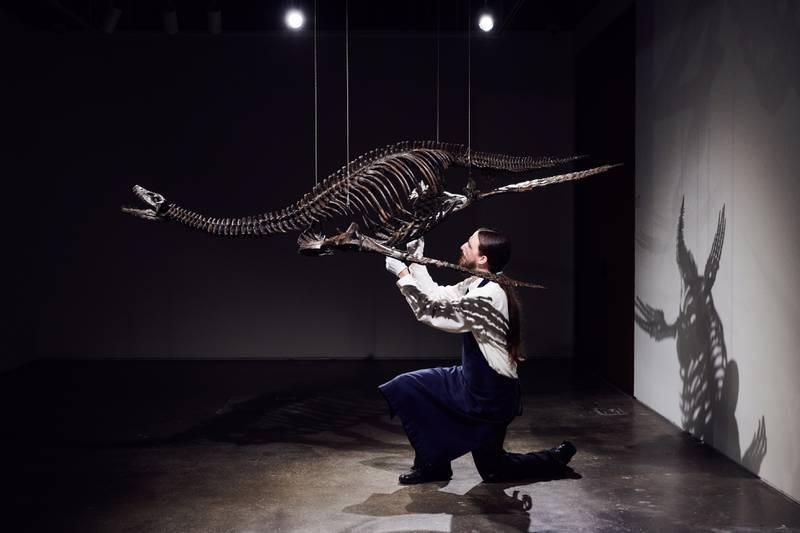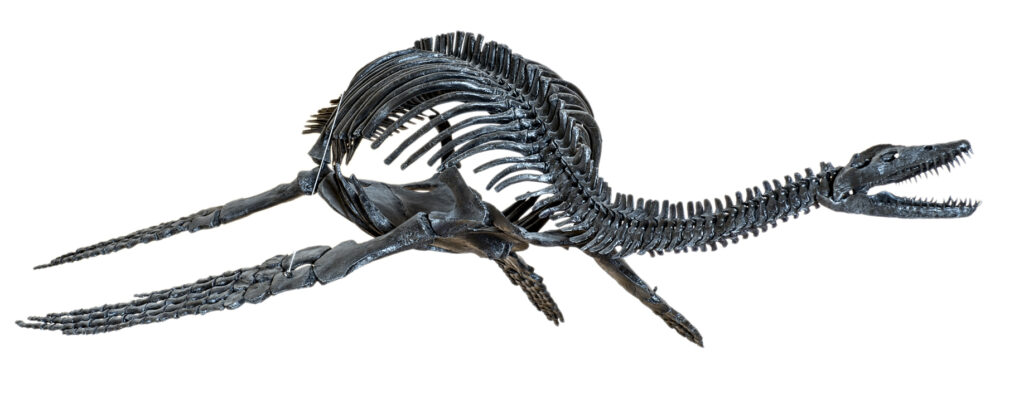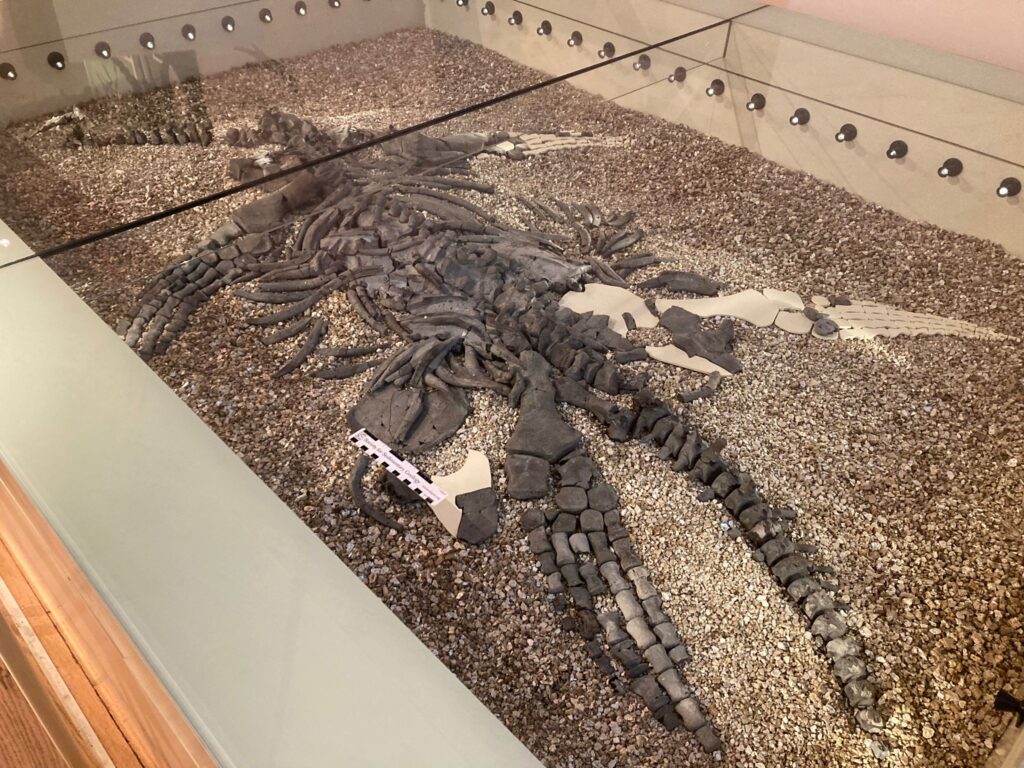The Return of the Blockley Plesiosaur
In summer 2023 a plesiosaur skeleton was offered at auction by Sotheby’s that may have looked familiar. This notable specimen is the ‘Blockley Plesiosaur’, originally offered at auction by Sotheby’s in 2010. This is a potentially significant specimen so I’m flagging it up to briefly discuss the provenance, history, and taxonomic identity of this curious skeleton.

The Blockley Plesiosaur was found in Blockley Pit (=Blockley Station Quarry, now Wellacre Quarry) in Gloucestershire, UK, in 1990 by Steve Callaway and Terry Smith (Mellroy 1990). It’s one of two plesiosaurs found in Blockley that year. The other, found by the same collectors, is mounted in plaster on display in the Gloucester City Museum and Art Gallery (Mellroy 1990, Evans 2012). A third plesiosaur was later found in Blockley in 2000, see below. Roger Higgs (2023) calls the specimen in Gloucester Museum ‘Blockley Plesiosaur 1’, the specimen offered at Sotheby’s in 2010 ‘Blockley Plesiosaur 2’, and the specimen found in 2000 ‘Blockley Plesiosaur 3’. So, to avoid any ambiguity, when I say Blockley Plesiosaur in this article I’m referring to ‘Blockley Plesiosaur 2’ unless otherwise stated.
The strata at Blockley are early Pliensbachian in age (Early Jurassic), ~188 million years old. Up until recently there was a ‘Pliensbachian gap’ in the plesiosaur fossil record, so the Blockley Plesiosaur was particularly important at the time it was discovered, and the transfer of the skeleton into probably private hands was seen as a loss to palaeontology. Several plesiosaur genera have subsequently been described and named from the Pliensbachian: Westphaliasaurus, Arminisaurus and Cryonectes. So, that gap is gradually being plugged, but the Blockley Plesiosaur is still a rarity and a potentially important specimen for understanding plesiosaur diversity and evolution during that time. The specimen, or casts of it at least, has been cited in peer-reviewed scientific literature (Carpenter 2010).
So, what is the Blockley Plesiosaur?
The Black Hills Institute have sold casts of the Blockley Plesiosaur under the name Plesiosaurus dolichodeirus. See the Black Hills Institute site here. One of these casts, pictured here, is on display in the ‘MUSE’ Science Museum (Museo delle Scienze di Trento Partita) in Italy.

However, there are differences between the Blockley Plesiosaur and Plesiosaurus dolichodeirus. For example, P. dolichodeirus is from the Sinemurian, so it is a little bit older than the Blockley specimen, and there are anatomical differences, most obviously in the shape of the humerus and coracoid. So the Blockley Plesiosaur is not Plesiosaurus dolichodeirus.
The Black Hills Institute give the specimen on their website the number BHI 126445. Carpenter (2010) also cites this number in a paper about plesiosaur swimming, where he figures casts of the limbs and pectoral girdle of the Blockley Plesiosaur. It isn’t completely clear whether this number refers to just the cast(s) or the original skeleton, but it suggests that the Black Hills Institute have had access to the original skeleton at some point. Carpenter (2010) regarded the specimen as a probable new genus and species.
A third substantially (85%) complete plesiosaur specimen from Blockley was discovered by Peter Blake in 2000 and purchased by the New Walk Museum in Leicester. That skeleton (LEICT G1.2002) has been on public display since 2011, laid out flat to show how it was preserved rather than being mounted in three dimensions. The Blockley Plesiosaur 3 formed the basis of a 2012 PhD thesis by Mark Evans who was a curator at the New Walk Museum at the time. He regarded it as a new genus and species, but although the potential holotype material has been vigorously defined and is certainly diagnostic, a name has not yet been formally established for it in the published peer-reviewed literature.

However, Evans (2012) regarded Blockley Plesiosaur 2 as the same taxon as Blockley Plesiosaur 3 on the basis of diagnostic features visible in images of BHI 126445 (including those figured in Carpenter 2010).
It is referred…due to the outline of the humerus and the pectoral girdle morphology, which includes a cordiform coracoid embayment.
Mark Evans (2012)
So, there we have it, the Blockley Plesiosaur is ‘something else’, a new genus and species, but it hasn’t been formally named yet.
Completeness
Aesthetically, this is a rather nice mounted skeleton, but there are some questions about its completeness.
The skeleton is about 75 percent complete and in exceptional condition, said Cassandra Hotton, Sotheby’s head of Science and Popular Culture.
https://www.france24.com/en/live-news/20230711-dinosaur-bones-evoking-loch-ness-monster-to-be-auctioned-sotheby-s
There are different ways to estimate completeness, some more generous than others. So, the 75% figure is probably a maximum estimate, and Higgs (2023) says the skeleton is about 50% complete. You can just about make out the difference between the fossil bone and the replica bone in some of the close up photos on the auction pages. The fossil bone appears to be light brown, while the replica parts seem to be a darker shade of brown. It would certainly be possible for a palaeontologist viewing the skeleton in person to tell the difference, and this is important because the colour difference won’t be apparent in any casts made from the original.
The 2023 auction closed on July 26, so it will be interesting to see what happens to the Blockley Plesiosaur next.
References
Carpenter, K. 2010. Plesiosaur swimming as interpreted from skeletal analysis and experimental results. Transactions of the Kansas Academy of Science, 113, 1–34.
Evans, M. 2012. A new genus of plesiosaur (Reptilia: Sauropterygia) from the Pliensbachian (Early Jurassic) of England, and a phylogeny of the Plesiosauria. Unpublished PhD thesis, University of Leicester.
Higgs, R. 2023. Blockley Jurassic ‘Sea Dragon’ Plesiosaurs. The Voice, March 2023, p.4.
Mellroy, A. J. 1990. Sea dragon skeletons found. Newspaper article (clipping in the Blockley Heritage Society archive, source unknown).
Sachs, S. and Kear, B. 2018. A rare new Pliensbachian plesiosaurian from the Amaltheenton Formation of Bielefeld in northwestern Germany. Alcheringa, 42, 487–500.
Vincent, P., Bardet, N. and Mattioli, E. 2012. A new pliosaurid from the Pliensbachian, Early Jurassic of Normandy, Northern France. Acta Palaeontologica Polonica, 58 (3), 471-485.

Hi my name is Steve callaway ,I was the finder of both specimens,these were placed in the hand of Mr David soul to rebuild and find interested parties,a shame because we were left out of the loop.
Only have photos to look back on.
Thanks for the comment Steve. I’d be happy to update the article with any extra information you’d like to share about their discovery and excavation, and I’d be interested to see the photos you mention. I may drop you an email if you don’t mind.